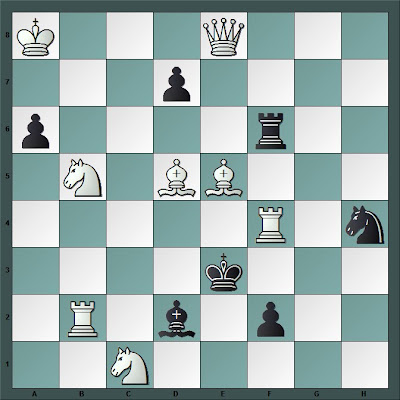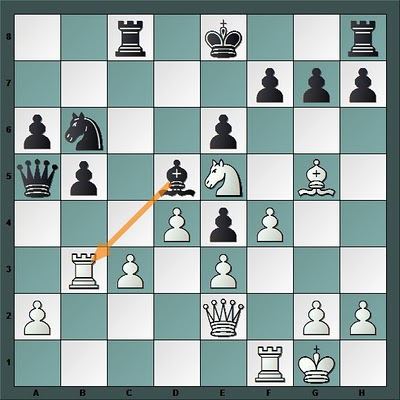Akiba Rubinstein, a lithograph portrait from David Friedmann's portfolio: Koepfe berhuemter Schachmeister. Copyright © 1999 Miriam Friedman Morris.
Akiba Rubinstein's involvement with chess in Palestine has been quite intensive. The very first game printed in the very first chess column ever to come out in Palestine -- in, of all places, the
Palestine News, which, as its masthead declares, was 'The weekly newspaper of the Egyptian Expeditionary Force of the British army in occupied enemy territory', published 'at G.H.Q. [General Headquarters - A.P.], First Echelon, Palestine' -- was (on May 7th, 1918) Rubinstein’s “polish immortal” game against
Rotlewi in Łódź, 1907, annotated by
Edward Lasker. There is no need to repeat it here.
Five years later, in September 1923, the Lasker chess club in Jersualem scored another first: the publication of
Ha’shachmat, Yarchon Lehovevey Ha’shach Be’eretz-israel U’be’hutz-La’aretz [Chess: A Monthly for Chess Enthusiasts in Palestine and Abroad], 'published by the Jerusalem chess club "Emanuel Lasker"'. It adds on the first issue’s first page that 'great Jewish masters abroad promised their regular contribution'. The magazine's hopes were dashed -- only four (or three, the first being a double issue) issues appeared, in Sept. 1923 (Vol. 1 No. 1-2), June 1924 (Vol. 1 No. 3) and Sept. 1924 (Vol. 1 No. 4). However, Rubinstein -- one of the masters who promised to contribute -- had published 'Al Dvar Ha’tchalat Ha’partia' [About the Opening] in
Ha’shachmat, Vol. 1 No. 3 (June 1924), p. 34.
The article itself is very basic: Rubinstein advises to control the center, to emphasize development over material, and so on. It is so basic, in fact, that the editors add the note that 'this material is probably well known to many of our readers, but beginners will find it very useful'—a rather dubious claim for a one-page article containing not a single opening or variation but only general principles, including some ('we must not hesitate to sacrifice if only we can interfere with the opponent’s regular development') that are bound to be misapplied by beginners.
In addition, the Rubinstein chess club, founded in the 1920s, was of course named in his honor. (The two other most famous clubs in Israel or Palestine were also named after Jewish chess masters -- the
Reti club and the
Emanuel Lasker club.)
Nevertheless, it is both the very first article written especially for a Palestinian chess magazine (or chess column) by any leading master, and also the very first article written by a leading master for such a magazine in Hebrew. The editors emphasize that the article is not a translation, but that it is presented 'as originally written' by Rubinstein in his (excellent, if ‘old-fashioned’) Hebrew, a legacy of his early religious education.
Adds
Moshe Czerniak in his book,
Toldot Ha'sachmat Me'Reshito ve'ad Yameyni [The History of Chess from its Beginning to Our Day] (Mizrachi Books, Printed by Mofet Press:Tel Aviv, 1963), p. 57:
When Rubinstein was asked to contribute a few words to the publication, he was told that, to make things easier for him, he can write in any language he wants. Rubinstein replied, innocently: 'And what makes you think I can't write in Hebrew?'.
In the last issue of
Ha'shachmat (Vol. 1 no. 4, p.65) the editor,
Aryeh Leob Mohilever, notes further successes in corralling foreign masters to contribute: five more original problems were received from
Speiser, (making a total of 13); Rubinstein is sending a follow-up article, 'On the Middlegame'; and
Mieses will send an unspecified 'chess contribution'. Unfortunately, due to the magazine folding, none of these appeared.
The next step was Rubinstein appearing 'in the flesh'. In April-May 1931, Rubinstein visited Palestine and 'gave simultaneous displays' (Czerniak, Ibid.). Both Czerniak and
Eliyahu Fasher, in
Shachmet le'Hana'atcha [Chess for your Enjoyment] (2nd ed., Cabri 1980, p. 178) claim the visit was in 1929 or in 'the late 20s', respectively, probably by mistake. Fasher adds (Ibid) that it was the excitement over Rubinstein's arrival that got him interested in chess in the first place!
A photograph of Rubinstein playing with
Haim Nachman Biyalik, the famous poet, in the 24/5/1931 simultaneous display in Tel Aviv
here, and two games are
here and
here. Note that I have found the original publication the second game (a loss by Rubinstein), added the original punctuations and annotations, and corrected some mistakes in the game score.
In an additional report,
Davar, on Friday,24/4/31, said (Bolding of first line is
sic, my comments in brackets. Spelling of names -- except Rubinstein's, of course -- is phonetic):
Haifa [Mandatory Palestine]. Akiba Rubinstein's Simultaneous Display. On Wednesday night [22/4/31] the simultaneous display of chess master Akiba Rubinstein was conducted in the Technion's hall against 61 51 [corrected 30/6/2012] opponents. Mr. G. Levin addressed the guest in the name of the community's governing committee. The game lasted from 9 P.M. to 5:30 A.M. Results: five won, eight drew. The winners: the brothers Ne'eman from Bat-Galim (14 and 18 years old), Seprizer, Weil, and Aharoni (from Zichron Ya'akov).
I am not aware of any other simultaneous display that took place in such odd hours, nor of a two-brother 'team' both winning in a simultaneous display against a leading master. It is indicative of the popularity of chess at the time that this report was printed, not in the chess column, but in the regular 'current events' section..
More games -- or a complete list of Rubinstein's simultaneous displays -- would be very welcome.






